You can spend half a day at Pisa if you only visit the Square of Miracles, but it would be a shame not to discover the rest of the city. The historic centre along the borgo or the Piazza dei Cavalieri, the banks of the Arno, and its beautiful churches are just some of the highlights.
See also at the end of page Tourist map of Pisa
Read also the presentation of Pisa
Piazza dei Miracoli and Leaning Tower
Earth brought back to the Middle Ages was dispersed into a limited space to form the sacred area called Piazza dei Miracoli (Square of Miracles in English). This unique site has been inscribed on the UNESCO heritage list. Four majestic buildings were built in the 11th and 12th centuries: the cathedral, the leaning tower, the baptistery and the old cemetery.
The famous Tower of Pisa built in the 12th century is 55 meters high, and began to lean from its construction! In fact, all the buildings in the area are more or less inclined.
→ See also the page about Square of Miracles in Pisa
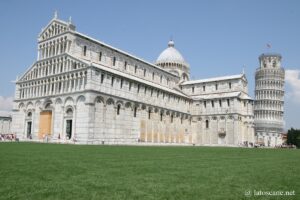
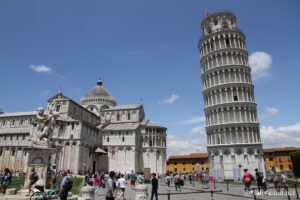
Lungarni of Pisa
The banks of the Arno (lungarni in Italian) are another major discovery in Pisa, lined with elegant palaces, churches and bustling daily life, including shops and bars. There are old residences of rich families from Pisa. However, many were rebuilt in the second half of the 19th century. The most beautiful of these buildings are the Palazzo dei Medici, the Palazzo Toscanelli, the church San Matteo in Soara and the gothic jewel of the church of Santa Maria della Spina.
On 16 June, the Luminara de San Ranieri will be held, with the banks lit by hundreds of flames.
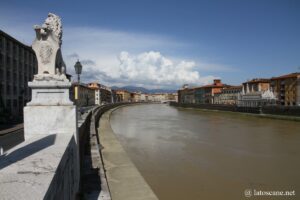
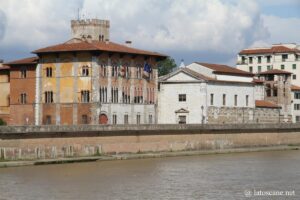
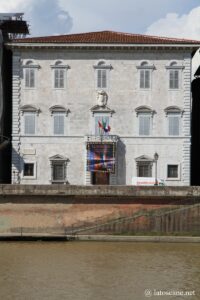
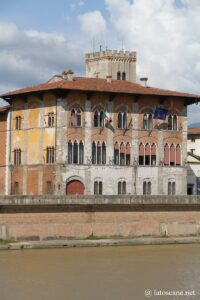
Borgo of Pisa
The Borgo Stretto is the name of a street that crosses the historic and most characteristic centre of Pisa, a large pedestrian street lined with arcades and beautiful palaces that can be traced back to the 14th and 15th centuries, including the Casino dei Nobili,
The street and surrounding area is characteristic and lively, with restaurants, terraces and bars, whose heart is the Piazza delle Vettovaglie, where also the historic food market.
From the Piazza del Pozzetto you can see the Borgo Largo, another part of the Borgo with its arcades.
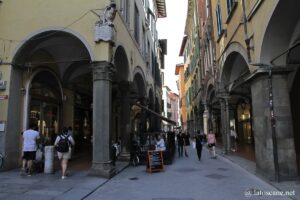
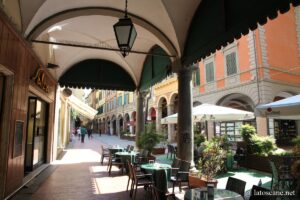
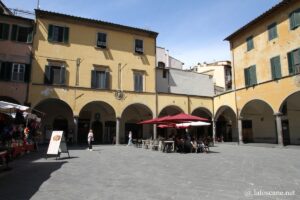
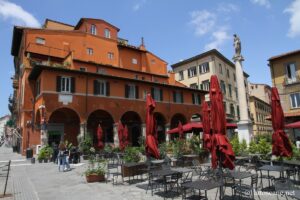
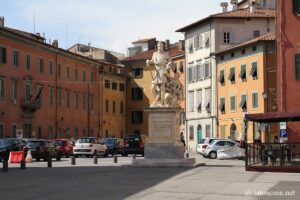
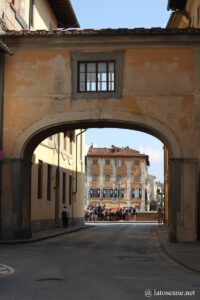
Piazza dei Cavalieri in Pisa
The Piazza dei Cavalieri is after the Square of Miracles the most remarkable square of Pisa, the political heart of the city for centuries, and formerly headquarters of the Order of the Knights of Order of Saint Stephen (founded by Cosimo I de’ Medici). It is still the seat of the prestigious Scuola Normale of Pisa in the Carovana Palace.
It is a masterpiece of the Renaissance, designed in the 16th century by Giorgio Vasari, also buildings such as the Palazzo dell’Orologio (Palace of the Clock in English, free visits on reservation), the church Santo Stefano dei Cavalieri designed by Vasari and the statue of Cosimo I Medici.
Also worth mentioning are the Palace of the Council of the Twelve and the Chiesa di San Rocco.
The church of Santo Stefano preserves in particular the painting of the Stoning of Saint Stephen by Giorgio Vasari, or a Nativity by Bronzino.
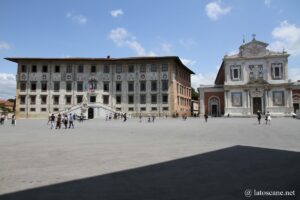
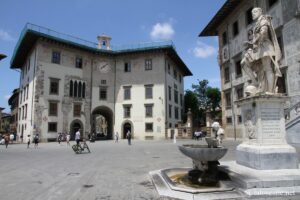
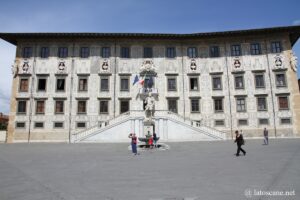
Royal Palace of Pisa
Built in 1159 along the Arno by the Caetani family, the Royal Palace of Pisa (Palazzo Reale in Italian) was rebuilt by the Medici family in the 16th century. It then hosted the Grand Dukes of Tuscany, then in the 19th century the Savoy with the King of Italy. It would also be here that Galileo presented to Cosimo I de’ Medici the invention of the astronomical telescope.
It now houses the National Museum of the Royal Palace which has many masterpieces that were partly inherited from the large families who lived there. Italian and Flemish paintings are on display, including the Portrait of Eleonore de Toledo, wife of Cosimo I.
It also has a collection of nearly 900 swords and armour that were used during the Gioco del Ponte (game of bridge in English) in the 17th century; tapestries of the Florentine school ; as well as acquisitions of porcelain, bronzes and ivories.
Church of Santa Maria della Spina
The Santa Maria della Spina church is a small gothic jewel located on the Lungarno Gambacorti. It was built around 1230 and took its name in 1333 when it hosted one of the spines of the crown of Christ (now kept in the church of Santa Chiara).
It surprises with its facade decorated with many carved marbles, such as arrows, statues, arches or rosettes, divided by a pillar bearing a Virgin and Child with two angels.
Modified and restored several times, it was even moved at the end of the 19th century, being dismantled and rebuilt a few meters away from the river from which it was too close in an unstable position.
The more austere interior houses a splendid Madonna della Rosa by Andrea and Nino Pisano.
Blu Palace in Pisa
This Blue Palace (Palazzo blu in Italian) located on the Lungarno Gambacorti is distinguished by its sky-blue facade, which would be the color of the eighteenth century, found on an old plaster during restorations. It houses a museum managed by the Foundation of Pisa, an important section of which is dedicated to temporary exhibitions on the ground floor.
The museum preserves paintings dating from the 14th to the 18th century. The noble floor reproduces an aristocratic residence of the nineteenth century furnished with furniture and precious objects.
The archaeological and medieval section is located in the basement, with the remains revealed during the work on the palace.
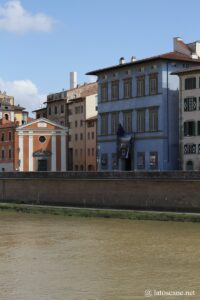
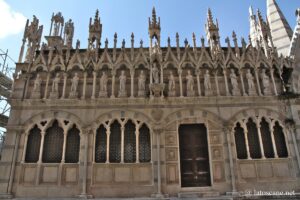
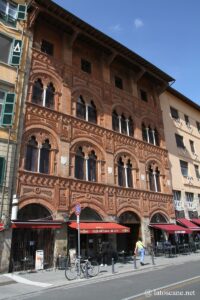
Arsenals of Pisa
The two arsenals of Pisa still bear witness to the city’s past maritime power. They are located along the banks of the Arno.
The Republican Arsenals are the oldest, dating back to the Republic of Pisa where the city’s ships were built for their speed.
The Arsenali Medici built the galleys, the great warships of the Medici fleet. They remained active until the Second World War. Now they serve as an exhibition venue, housing the Museum of the ships of Pisa whose discovery in 1998 remains of Roman boats and the ancient port very well preserved.
Botanical Garden of Pisa and Museum
The Botanical Garden of Pisa is the oldest university botanical garden in the world, founded in 1543 on the banks of the Arno and later transferred to the current site. It has seven sections with six thousand species from around the world and a museum.
Keith Haring’s Tuttomondo
This gigantic mural, created by the American street artist Keith Haring covers a surface of 180 m2 on the back wall of a convent, and was made in 1989. It features 30 figures embedded as if in a puzzle, images of a world at peace, Motherhood, nature, etc.
Churches of Pisa
Church of San Michele degli Scalzi
Located on the banks of the Arno, about 2 kilometres east of the centre of Pisa, the church of San Michele degli Scalzi dates back to at least the 11th century and was rebuilt between 1152 and 1171 with the annex monastery that housed the Benedictine Pulsanesi (also called “barefoot”). From the 15th to the 18th century, the monastery was occupied by the Brigidine Sisters, then by the Augustinians and by the Olivetane monks.
It was very damaged during the Second World War.
Its steeple tilted due to a subsidence of the ground is referred to as the “third leaning tower” of Pisa (after the ones on Square of the Miracles and the one of the church of Saint-Nicola). It has a square base, marble in the lower part, brick in the upper part.
The facade is divided into two orders. The marble portal has a Christ blessing from the early 13th century. The upper part is 17th century with its central rose window.
The central nave is framed by columns with Romanesque capitals from the 11th century. On the apse is a cross painted in Pisan-Byzantine style from the mid-13th century.
The monastery cloister was partly incorporated into a ceramic factory in the 19th century. It has two-order colonnades and cross vaults.
San Michele in Borgo church
Built in the 10th-11th centuries on the remains of a Roman temple dedicated to Mars, San Michele in Borgo was largely destroyed during the 1944 bombing, only the facade and the apse survived.
This façade illustrates the transition from Romanesque to Gothic with its two levels, the Roman-Pisan low of the thirteenth century, the upper part with rose-window and arches is from the 14th century.
The interior has three large naves where are preserved frescoes from the 13th century and a marble crucifix by Nino Pisano.
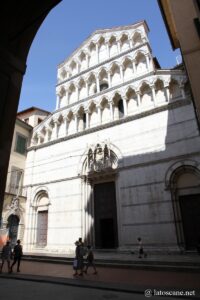
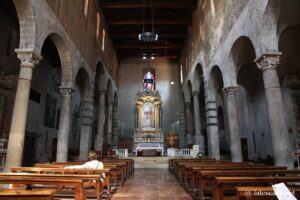
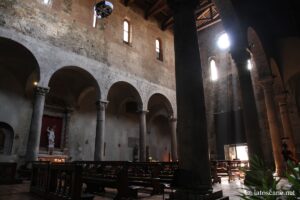
San Matteo church
The church of San Matteo and the adjacent monastery of the Benedictine nuns were built on the foundations of an older temple around 1027.
It was modified or restored several times, in particular at the beginning of the 17th century, and the interior at the beginning of the 18th century: vault with the Glory of S. Matteo of the Melani brothers, trompe-l’œil statues on the back facade, a 13th century crucifix, etc.
In the San Matteo Museum you can access the medieval cloister, redesigned in the 16th century. This museum preserves the monumental cross with a Christus patiens (Christ painful) from the early 13th century.
San Stefano dei Cavalieri church
San Stefano dei Cavalieri was the church for the Knights of Saint-Stéphane, a project by Vasari.
Its façade is in Carrara marble and it has a bell tower.
The coat of arms of the Order of Saint Stephen can be seen both on the outside and inside.
Among the works it houses are Stories of St. Stephen ; Stoning of St. Stephen by Giorgio Vasari, the Nativity of Christ by Bronzino.
the wooden ceiling is carved and presents several scenes: the Return from the Battle of Lepanto by Jacopo Ligozzi, The boarding of Marie de’ Medici in Livorno by Cristofano Allori, the Victory in the Greek Archipelago by Jacopo Chimenti, known as the Empoli and the Invasion of the city of Preveza by Ligozzi.
The marble baptismal font and the pulpit are by Giuseppe Fancelli.
Church of San Sepolcro
The church of the Holy Sepulchre (San Sepolcro in Italian) dates from 1138, attributed to the architect Diotisalvi, the creator of the baptistery on the Square of Miracles. It has an octagonal plan in reference to the temples of Jerusalem. The interior reproduces the Holy Sepulchre of Jerusalem, with eight equidistant pillars supporting the arches, with a pyramidal dome. It preserves a 15th-century Virgin and Child.
San Nicola church
Dating at least from the late 11th century, the church of San Nicola was a dependency of the monastery of San Michele della Verruca.
The first order of the facade has typical elements of the Roman-Pisan style of the 11th century with blind arches, pilasters framed by portals, Lozenges and oculus, marble coverings with white and black stripes. Very different, the second order would be of the sixteenth century, while the original octagonal bell tower is from the thirteenth century, also designated second leaning tower of Pisa not reason for its inclination.
A wooden Crucifix attributed to Giovanni Pisano is in a chapel, a Virgin with Child is attributed to Francesco Traini in the chapel of Madonna delle Grazie.
The painting of Saint Nicholas saves Pisa from the plague from the early 15th century is the oldest known representation of Pisa of this quality.
At the end of the 16th century, eight chapels and a vault were built, including the chapel of the Sacristy by Matteo Nigetti (1614).
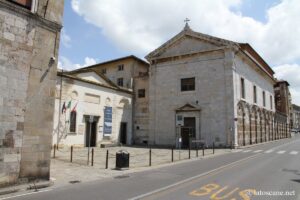
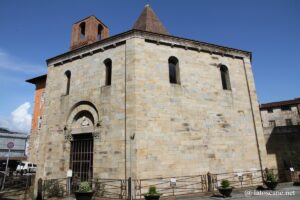
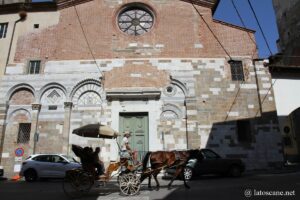
San Francesco church
The 13th-century church of San Francesco was enlarged in the 16th-17th centuries. Its roof collapsed during a devastating earthquake in 1846. Sacrilegied in 1861, it was used as a military warehouse and reopened in 1901.
The 6 altars are located along the nave. The Sardi-Campiglia chapel is decorated with 14th century frescoes. The chapter house houses a marble polyptych by Tommaso Pisano.
Church of Santa Caterina in Alessandria
Dating at least from the early 13th century, the church of Santa Caterina d’Alessandria was later modified, notably in the 17th century after a fire.
The façade is decorated with white and grey marble, loggias and a large central rose window.
The interior has a nave. On the main altar is a wooden chair from which Saint Thomas Aquinas preached, the funeral monument of Gherardo di Bartolomeo and that of Archbishop Simone Saltarelli carved by Andrea Pisano.
Church of San Pietro in Vinculis
Dedicated to Saint Peter, San Pietro in Vinculis is Romanesque with its original stone façade from the Lombard period.
It preserves above all a superb crypt with its vaults decorated with frescoes of the fourteenth century. The names of the people buried here are written on columns.
The interior has a marble floor of cosmatesque style, with its polychrome geometric patterns of the 12th century.
The church kept for two centuries the codex of the “Corpus Iuris Civili”, called the “Pandette Pisane”, an important document that brings together the laws of the Roman Empire at the time of the Byzantine emperor Justinian I. Pisans would have acquired it in 1137 during the sack of Amalfi. In 1406, the Florentines took it as a spoils of war and renamed it “Pandette Fiorentine”, which is kept in the Laurenziana Library.
San Sisto church
San Sisto in Cortevecchia is an ancient church of Pisa that has retained its original forms. It was built in 1087, after the conquest of Al Mahdiya in Tunisia. It was restored between the 15th and 18th centuries.
The stone façade is tripartite, in Roman-Pisan style, decorated with blind arches and Islamic majolica ceramics, with an unusual bell tower.
The interior is dark and suggestive with three naves divided by columns and their Roman capitals.
The church houses the rudder of a 14th-century Pisan ship or the tombstone of the emir Al Murtada as a memorial to the conquest of the Balearic Islands (1165).
Santa Cristina di Lungarno church
An old church dating back to the 8th century, Santa Cristina di Lungarno was located near the disappeared Roman bridge that came in front of the present-day Blue Palace.
The apse dates from the 10th century. But the 19th century restorations have modified the structure and ornaments. This is the site of the miraculous episode when Saint Catherine of Siena received the stigmata while praying in front of a large crucifix painted from the 12th century on 1 April 1375. The original work was transferred to Siena by Cosmas I in 1565, replaced here by a copy.
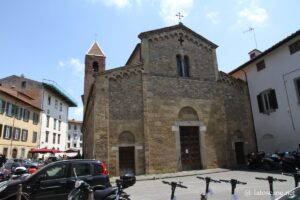
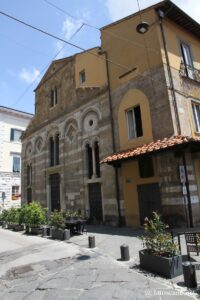
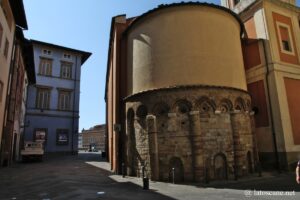
San Paolo a Ripa d’Arno church
The beautiful San Paolo church in Ripa d’Arno is located near the Sonnino lungarno and the Benedictine complex.
Dating back to the 10th-11th centuries, it is one of the oldest churches in Pisa, and cathedral when the current was under construction on Square of the Miracles.
It was rebuilt after its destruction during the bombing of 1943. Its exterior has been partially preserved, with its Roman-Pisan style, including blind arcades, rosettes and rhombuses.
The interior was completely rebuilt, but retains the frescoes of Buffalmacco and a superb Roman sarcophagus that became the tomb of Burgundio (important Pisan jurist of the 12th century).
Behind the building, the St. Agatha chapel has an octagonal structure and was probably the old baptistery.
Tourist map of Pisa
If you see this after your page is loaded completely, leafletJS files are missing.
Links and sources
- Tourist portals: www.turismo.pisa.it, www.visitapisa.it, www.liquidarte.it
- Informations : it.wikipedia.org
Articles about Pisa
- Pisa
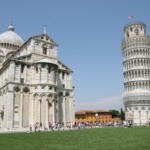 Pisa is a famous Tuscan city, famous all over the world thanks to its leaning tower, simply called Tower of Pisa, which has become one of the symbols of Italy, ...
Pisa is a famous Tuscan city, famous all over the world thanks to its leaning tower, simply called Tower of Pisa, which has become one of the symbols of Italy, ... - Hotels in Pisa
 Book now an accommodation in Pisa, among hundreds of solutions, from the hotel to the apartment or bed and breakfast and agritourism in the surroundings
Book now an accommodation in Pisa, among hundreds of solutions, from the hotel to the apartment or bed and breakfast and agritourism in the surroundings - Visits and guided tours in Pisa
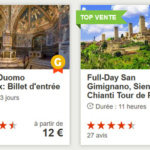 Guided tours, reservations and entrance tickets to Pisa, including the Square of Miracles with the Leaning Tower, the Cathedral and other monuments Into the same category
Guided tours, reservations and entrance tickets to Pisa, including the Square of Miracles with the Leaning Tower, the Cathedral and other monuments Into the same category - History of Pisa
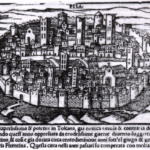 Perhaps Ligurian or Greek at its origins, Pisa was then an Etruscan city, before becoming a Roman colony. The Romans built a port there, which was very active. It later ...
Perhaps Ligurian or Greek at its origins, Pisa was then an Etruscan city, before becoming a Roman colony. The Romans built a port there, which was very active. It later ... - Weather in Pisa
 Weather forecast in Pisa for the next days and weeks, sunshine and temperatures, air quality Weather forecast 5 days in Pisa Complete weather in Pisa Into the same category
Weather forecast in Pisa for the next days and weeks, sunshine and temperatures, air quality Weather forecast 5 days in Pisa Complete weather in Pisa Into the same category

No Comments Yet